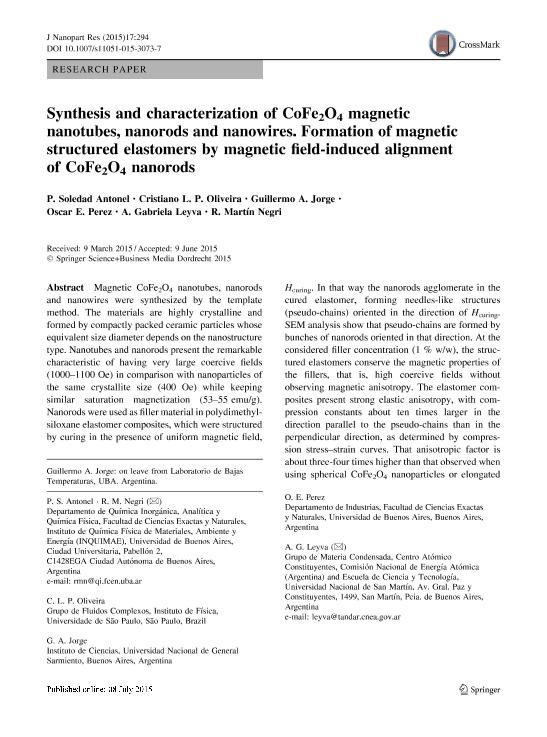Mostrar el registro sencillo del ítem
dc.contributor.author
Antonel, Paula Soledad

dc.contributor.author
Oliveira, Cristiano L. P.
dc.contributor.author
Jorge, Guillermo Antonio

dc.contributor.author
Perez, Oscar Edgardo

dc.contributor.author
Leyva de Guglielmino, Ana Gabriela

dc.contributor.author
Negri, Ricardo Martin

dc.date.available
2018-04-10T19:28:00Z
dc.date.issued
2015-06
dc.identifier.citation
Antonel, Paula Soledad; Oliveira, Cristiano L. P.; Jorge, Guillermo Antonio; Perez, Oscar Edgardo; Leyva de Guglielmino, Ana Gabriela; et al.; Synthesis and characterization of CoFe2O4 magnetic nanotubes, nanorods and nanowires. Formation of magnetic structured elastomers by magnetic field-induced alignment of CoFe2O4 nanorods; Springer; Journal of Nanoparticle Research; 17; 294; 6-2015; 294-308
dc.identifier.issn
1388-0764
dc.identifier.uri
http://hdl.handle.net/11336/41578
dc.description.abstract
Magnetic CoFe2O4 nanotubes, nanorods and nanowires were synthesized by the template method. The materials are highly crystalline and formed by compactly packed ceramic particles whose equivalent size diameter depends on the nanostructure type. Nanotubes and nanorods present the remarkable characteristic of having very large coercive fields (1000-1100 Oe) in comparison with nanoparticles of the same crystallite size (400 Oe) while keeping similar saturation magnetization (53-55 emu/g). Nanorods were used as filler material in polydimethylsiloxane (PDMS) elastomer composites, which were structured by curing in the presence of uniform magnetic field, Hcuring. In that way the nanorods agglomerate in the cured elastomer, forming needles-like structures (pseudo-chains) oriented in the direction of Hcuring. SEM analysis show that pseudo-chains are formed by bunches of nanorods oriented in that direction. At the considered filler concentration (1 % w/w), the structured elastomers conserve the magnetic properties of the fillers, that is, high coercive fields without observing magnetic anisotropy. The elastomer composites present strong elastic anisotropy, with compression constants about ten times larger in the direction parallel to the pseudo-chains than in the perpendicular direction, as determined by compression stress-strain curves. That anisotropic factor is about three-four times higher than that observed when using spherical CoFe2O4 nanoparticles or elongated Ni nanochains. Hence, the use of morphological anisotropic structures (nanorods) results in composites with enhanced elastic anisotropy. It is also remarkable that the large elastic anisotropy was obtained at lower filler concentration compared with the above mentioned systems (1 % w/w vs. 5-10 % w/w).
dc.format
application/pdf
dc.language.iso
eng
dc.publisher
Springer

dc.rights
info:eu-repo/semantics/openAccess
dc.rights.uri
https://creativecommons.org/licenses/by-nc-sa/2.5/ar/
dc.subject
Magnetic Nanorods
dc.subject
Magnetic Nanotubes
dc.subject
Structured Elastomers
dc.subject
Magnetic Composites
dc.subject.classification
Nano-materiales

dc.subject.classification
Nanotecnología

dc.subject.classification
INGENIERÍAS Y TECNOLOGÍAS

dc.title
Synthesis and characterization of CoFe2O4 magnetic nanotubes, nanorods and nanowires. Formation of magnetic structured elastomers by magnetic field-induced alignment of CoFe2O4 nanorods
dc.type
info:eu-repo/semantics/article
dc.type
info:ar-repo/semantics/artículo
dc.type
info:eu-repo/semantics/publishedVersion
dc.date.updated
2018-04-10T14:18:31Z
dc.identifier.eissn
1572-896X
dc.journal.volume
17
dc.journal.number
294
dc.journal.pagination
294-308
dc.journal.pais
Países Bajos

dc.journal.ciudad
Dordrecht
dc.description.fil
Fil: Antonel, Paula Soledad. Consejo Nacional de Investigaciones Científicas y Técnicas. Oficina de Coordinación Administrativa Ciudad Universitaria. Instituto de Química, Física de los Materiales, Medioambiente y Energía. Universidad de Buenos Aires. Facultad de Ciencias Exactas y Naturales. Instituto de Química, Física de los Materiales, Medioambiente y Energía; Argentina
dc.description.fil
Fil: Oliveira, Cristiano L. P.. Universidade de Sao Paulo; Brasil
dc.description.fil
Fil: Jorge, Guillermo Antonio. Universidad Nacional de General Sarmiento. Instituto de Ciencias; Argentina. Consejo Nacional de Investigaciones Científicas y Técnicas; Argentina
dc.description.fil
Fil: Perez, Oscar Edgardo. Consejo Nacional de Investigaciones Científicas y Técnicas. Oficina de Coordinación Administrativa Ciudad Universitaria. Instituto de Química Biológica de la Facultad de Ciencias Exactas y Naturales. Universidad de Buenos Aires. Facultad de Ciencias Exactas y Naturales. Instituto de Química Biológica de la Facultad de Ciencias Exactas y Naturales; Argentina
dc.description.fil
Fil: Leyva de Guglielmino, Ana Gabriela. Comisión Nacional de Energía Atómica; Argentina
dc.description.fil
Fil: Negri, Ricardo Martin. Consejo Nacional de Investigaciones Científicas y Técnicas. Oficina de Coordinación Administrativa Ciudad Universitaria. Instituto de Química, Física de los Materiales, Medioambiente y Energía. Universidad de Buenos Aires. Facultad de Ciencias Exactas y Naturales. Instituto de Química, Física de los Materiales, Medioambiente y Energía; Argentina
dc.journal.title
Journal of Nanoparticle Research

dc.relation.alternativeid
info:eu-repo/semantics/altIdentifier/url/http://link.springer.com/article/10.1007/s11051-015-3073-7
dc.relation.alternativeid
info:eu-repo/semantics/altIdentifier/doi/http://dx.doi.org/10.1007/s11051-015-3073-7
Archivos asociados
